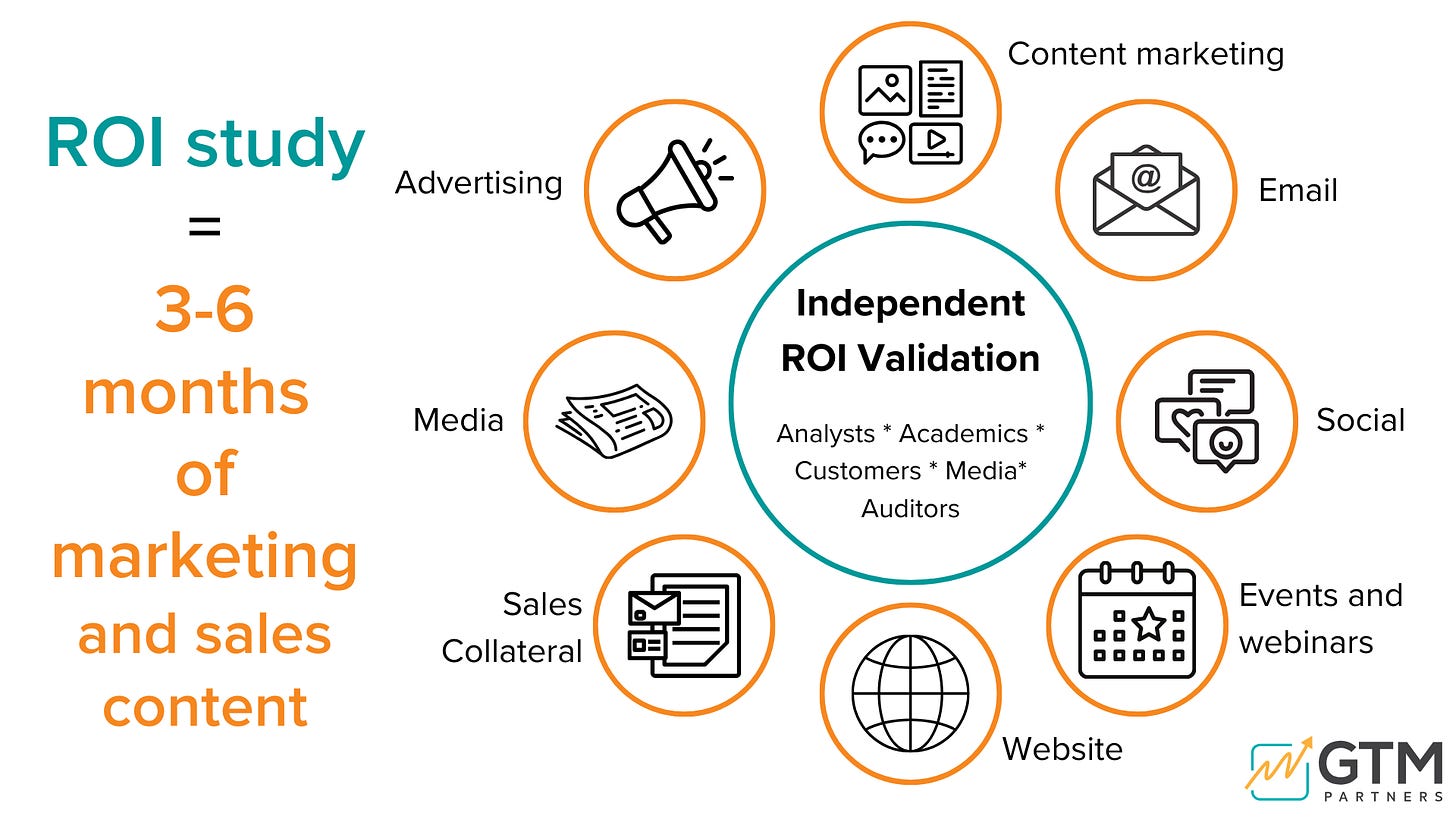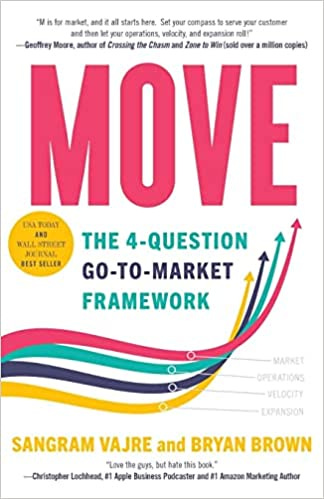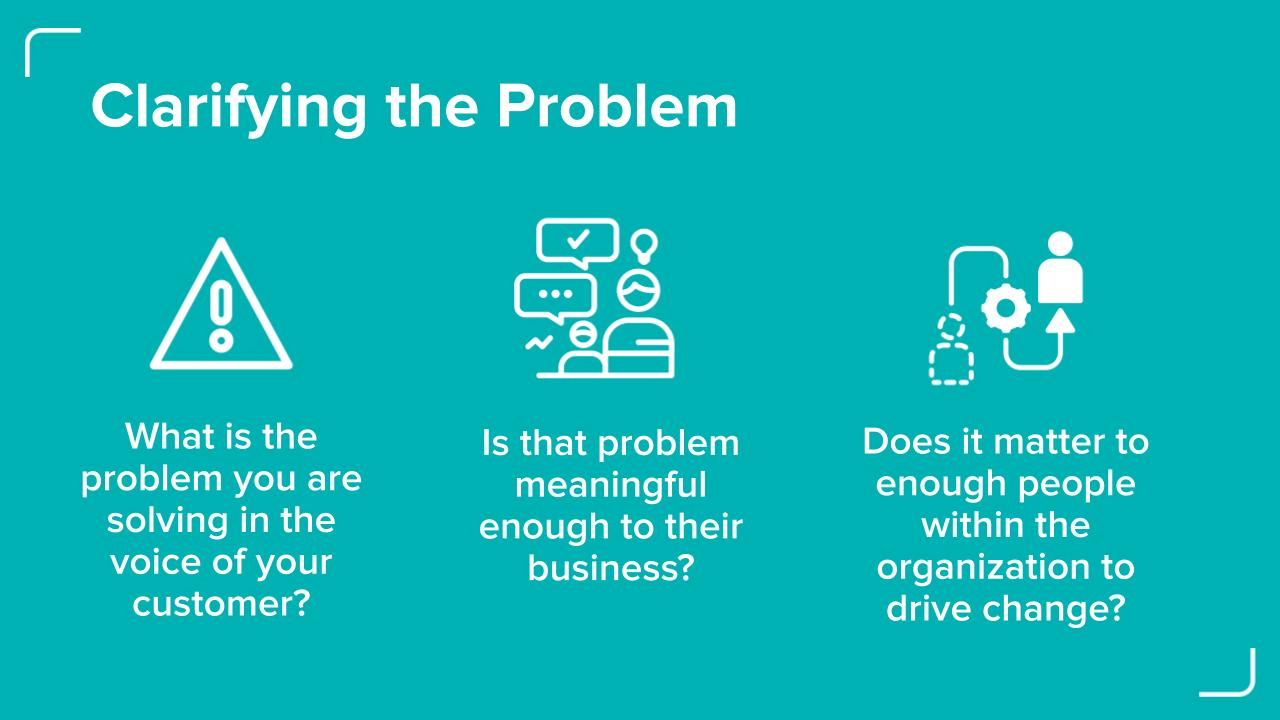Filters
Your ROI Playbook for 2024
As a GTM leader, you need to think about ROI in two ways:
Internal Audiences: Can you proved that your investments in GTM technology, processes, and people are paying off when you ask for more budget (e.g. NRR, CAC, LTV, SQLs, etc.)?
Customers: Can you show your customer that your product/service will deliver one of the 5 kinds of ROI in a compelling and credible way that resonates with customers?
We’ve talked about #1 extensively, and if you really want to speak your CEO/ CFO’s love language, show them this scorecard along with a plan you have for getting all the numbers.
Let’s talk more about #2.
How should you get credible, validated, third-party ROI to share with customers?
How can you activate and share that ROI in the most impactful way with your Total Relevant Market?
In this post, we’ll teach you how to do it yourselves and then share info at the end about how we can help if you need it.
5 reasons you should want your ROI to have independent, third-party validation
Once you understand and have demonstrated your ROI (no easy task, but skipping over that part since we’ve written about it before), you need to show it has independent third-party validation.
Why?
Credibility and trust: Third-party validation adds credibility to your ROI claims. What better way to show you’re an open book and have results independently assessed. Talk about building trust with potential customers!
Objectivity: Third-party validators are typically neutral parties without a vested interest in the success of your product or service, which means your ROI data is not biased or manipulated.
Reduced skepticism: Let’s face it: today’s B2B buyers are sophisticated and aren’t taking much marketing has to say at face value. But if you share stats that someone else came up with, customers are more likely to believe it.
Risk reduction: Customers want to minimize the risk associated with their investments. If they see that a reputable third-party has validated your ROI claims, they may feel more confident that their investment will yield positive results.
Data accuracy: Independent third parties can help ensure the accuracy of your ROI calculations and data, preventing any unintentional errors or misrepresentations that could damage your reputation.
5 Ways to Get Third-Party Validation
Here are five tried-and-true ways that one or more of us on the GTMPartners team have used to prove ROI in our past lives.
1. Analyst Firms
You know we’re an analyst firm, right? But we’ll put ourselves last on this list, because we believe so much in ROI, we want you to get it from anyone you want to. There is more than enough ROI work to keep us all busy!
If you’re already working with one of these companies, ask them about pricing and process for their ROI work and get it going! We have no time to waste for 2024!
Forrester Research: Forrester’s ROI report is called a Total Economic Impact Report (TEI). Learn more here.
Gartner: Gartner customers can use this tool or pay to have Gartner conduct ROI analysis and assessments for a wide range of B2B products and services.
IDC (International Data Corporation): IDC offers a Business Value White Paper.
GTM Partners: Yours truly… we can evaluate your product or services’ ROI using customer interviews, G2 data, case studies, and more. See examples of our work here.
2. Academics/Universities
Depending on the nature of your product/service, there is almost certainly someone studying it at a university somewhere.
These professors are often willing to do independent research to validate your claims as a side hustle or a way to get additional department funding.
Hire an academic knowing they will be independent, and if their research doesn’t show what you thought it would, they’re not going to say something they don’t believe.
But if you have confidence in your claims and a hefty budget, it can be very compelling to say that your claims are validated by XYZ well-known university.
Side note: this method also works well for making a broader ROI case for a specific kind of solution.
Many academics may not be willing to risk independence by validating a specific company - though some will. But if you’re trying to create a category, academics are excellent at validating the need for a solution overall. Then you can connect the dots for customers.
3. Customer Case Studies
Sometimes customers don’t come across as quite as independent as an analyst or academic, but they can be.
Your customers are your best advocates. If they say you provided ROI, prospects are more likely to trust your claims.
Tip: Make it a part of your QBR process to try and ask pointed, leading questions about ROI. This technique will not only improve retention rates (they will be more likely to renew if you hold their hand and show them how much value they got), it also provides valuable marketing content.
CSMs will need to be trained to handle the ROI discussion skillfully in the account management/review process.
4. Media Relations
The New York Times is not going to write about the fact that you got ACME Software a 21% increase in pipeline velocity after they implemented your tool.
However, there are tons of trade magazines and blogs and podcasts and LinkedIn influencers who are desperate for content. If you have a great customer case study and the customer is willing to talk, you should absolutely pitch them and their story.
5. Independent Audits
Although they are expensive and not commonly used by B2B firms, an independent audit with a reputable firm can be a powerful way to add credibility to your claims and reassure potential customers that the numbers are accurate.
8 Ways to leverage your ROI study
Not only does an ROI study make prospects and customers trust you more.
Not only does it reduce skepticism and risk.
Not only does it help you close faster, bigger deals.
The icing on the cake is that it gives you 3-6 months of the best marketing content you will ever have.
Here’s what we would do with a credible, independent, third-party ROI study to get the absolute most bang for our buck.
Content marketing:
Create blog posts, articles, and whitepapers that highlight key findings.
Develop case studies that showcase real-world customer examples.
Produce infographics or visual content that summarizes the ROI data.
Create compelling video content (explainer videos or customer testimonials).
Email campaigns:
Share ROI study via targeted email campaigns to customers and prospects; focus on segmentation where possible, and matching ROI to persona.
Social media:
Share ROI study snippets and highlights on social media platforms.
Enable customers to easily share their own ROI success stories, using templated graphics and pre-written copy.
Webinars and events:
Host webinars or seminars where you present the ROI study findings with customer advocates.
Present the ROI study at industry events and conferences, either delivered by your leadership or by customers (who often don’t have to pay to speak or sponsor).
Website:
Create a call to action on your homepage that links to your ROI study.
Design dedicated landing pages with strong CTA’s that offer ungated reports or case studies.
Sales collateral:
Equip your sales team with ROI-focused materials, including ROI calculators, sales presentations, and one-pagers.
Train sales representatives to effectively communicate the ROI potential to prospects.
Media outreach:
Issue a press release with ROI study results and quotes from the author.
Reach out to trade publications, blogs, podcasts, and others who might cover your proven, third-party validated ROI.
Advertising and direct mail:
Use PPC, display, social, and SEM campaigns to promote the ROI study to a wider audience.
How GTM Partners does ROI studies
As we’ve hopefully proven, you can do ROI studies from many sources and activate them in lots of ways.
GTM Partners also has a methodology for producing ROI studies.
Interview you to understand top use cases, personas, and value propositions.
Review case studies and other materials you provide.
Mine G2 review data to validate your use cases and value props.
Contact 2 - 3 customers (who speak to your ICP) and solicit a case study.
Here’s what you get with a GTM Partners’ case study:
ROI Study: A 4-5 page document that you can leverage throughout the customer journey as you see fit. It includes a 2 page analyst report and 2 - 3 pages of customer validation.
Webinar: Analyst participation on a webinar for your customers and prospects (with unlimited replay license)
Visibility: We post your ROI study on our content hub, in this weekly newsletter, and elsewhere.
Sales training: Our analyst will do a 30-minute sales training webinar for your team.
Activation guide: We will give you ideas and templates for a press release, social media posts, infographics, and 3-6 months worth of marketing content.
Marketing training: Our marketing leaders will teach your team how to activate the ROI study for best results.
We’d love to work with you on your ROI project, but hopefully it’s clear that we believe enough in the process to encourage you to make this a priority no matter how you get it done!
Share your news with us!
We want to be a resource for Go-to-Market leaders beyond sharing our own data. So please send us your:
GTM-focused job openings
Industry events focused on GTM functions
GTM research/data
GTM testimonials
Big company news that is legitimately of use or interest to a broad GTM audience.
On the road again
We’re going back on the road after a summer off, so if you are interested in one of our upcoming roadshows, register here to get a invitation to:
NYC, Sept. 21
Los Angeles, Nov. 3
San Jose, Dec. 8
Hope to see you at a virtual or in-person event soon!
The GTM Partners Team



